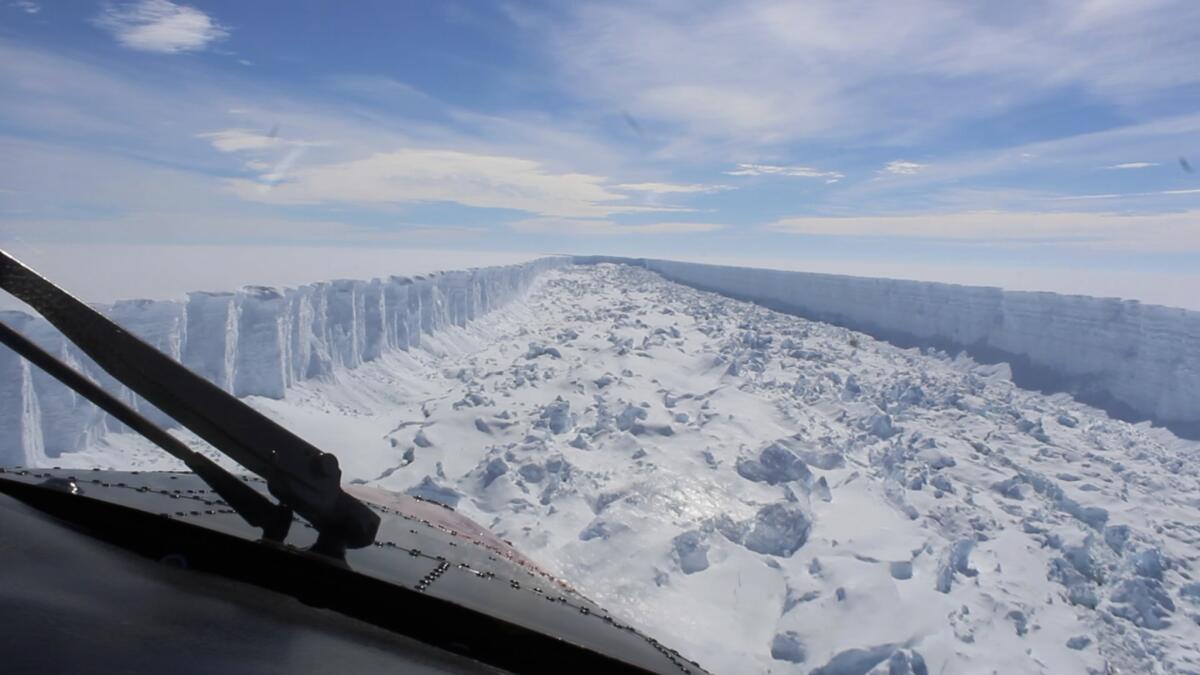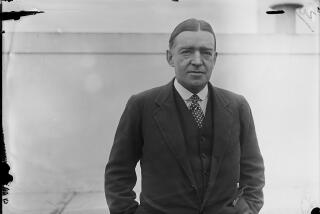To pierce the veneer of outside things: David Grann and the Antarctic
- Share via
In recent years the polar explorer Ernest Shackleton has become a posthumous self-help guru; books like “Leading at the Edge: Leadership Lessons from the Extraordinary Saga of Shackleton’s Antarctic Expedition” and “Shackleton: Leadership Lessons from Antarctica” litter the self-improvement section like discarded, frozen camping supplies. Decades after his death in 1922, Shackleton, best known for failing to reach the South Pole and then failing to complete a trans-Antarctic route, has become an icon of successful management under extreme duress, a textbook case of a role model gifted with people skills with a lot to teach today’s middle managers.
To Henry Worsley, the subject of David Grann’s latest book, “The White Darkness,” Shackleton was something more. Worsley, a British special forces officer born in 1960, was drawn to Shackleton’s story and the example he set. From a young age, he devoured accounts of polar exploration, with Shackleton always his vision of a courageous leader and adventurer. As he entered the military, he relied on Shackleton’s cues to establish himself as a well-liked and successful commander. As dreams of his own adventures gradually colonized his mind, Worsley decided to follow in his hero’s footsteps, literally: In 2008, when Worsley was 48, he and two other men re-created Shackleton’s failed journey to the South Pole.
Dragging 300-pound sleds behind them, they skied across the frozen continent, scaling treacherous glaciers, and on Jan. 9 reached Shackleton’s farthest point, 88 degrees 23 minutes south. While Shackleton turned back, realizing he did not have the resources to cover the final 112 miles, Worsley and his two companions (both descendants of Shackleton’s original crew) triumphed, making it to the South Pole on Jan. 18. Another expedition followed in 2012 — re-creating the famous 1912 race for the South Pole between Robert Falcon Scott and Roald Amundsen — and then a third expedition in 2015. This time, Worsley would attempt a grueling feat: crossing the entire continent of Antarctica, a thousand-mile journey through temperatures averaging minus 40 degrees Fahrenheit (combined with a debilitating windchill), unaided, entirely by himself. It is this journey, and the events that led to it, that are the basis of “The White Darkness,” a slim volume adapted from a New Yorker article supplemented with photographs that document the bleak and sublime landscape that captivated Worsley.
Grann recounts in sometimes gruesome detail the hardships Worsley endured as he attempted to cross the continent by himself — blistered and bruised feet, fingers numb with frostbite, a tooth broken from eating a frozen energy bar, a body wasting away no matter how much he ate. Worsley faced Antarctic blizzards that could last for days, “which sometimes whipped icy particles into a blinding cloud, making him so disoriented that he toppled over, his bones rattling against the ground.” Writing in his diary that January, Worsley confessed: “So breathless … I am fading … hands/fingers are forever shutting down … wonder how long they will last.”
At times, one cannot help but wonder, to what end all this suffering? When Sir John Franklin disappeared in the 1840s, he had been seeking trade routes; Robert Falcon Scott’s Discovery expedition had as a chief aim the advancement of scientific knowledge. But Shackleton primarily sought boasting rights, and for his trouble received nothing but suffering. Worsley, too, at times seemed to be motivated only by this goal of submitting to the ultimate hardship. Ostensibly, he was raising money for wounded veterans, but given the colossal expense in mounting these expeditions, it was hardly the most expeditious way to accomplish that.
The goal, it seems, was existential as much as anything. When Shackleton looked back on his ill-fated trans-Antarctic adventure, he wrote that he and his men “had pierced the veil of outside things,” reaching “the naked soul of man.” This, more than any philanthropy, seems to be what drove Worsley. He may have claimed to see in Shackleton a great leadership model, but a solo journey is not about leading others. “The White Darkness” tells the tale of how Worsley moved from one aspect of Shackleton’s legend — his inspiring leadership — to this other, deeper, more primal and unfathomable motive, to pierce the veneer of outside things.

Unlike Worsley’s grueling advance across an inhospitable continent, Grann’s prose moves at a brisk pace. Polar journeys are inevitably stories of monotony — the endless treks over unchanging landscape, the interminable periods of downtime waiting against the weather — but “The White Darkness” proceeds aplomb, with a style that conveys the immensity of Antarctica and the difficulty of Worsley’s journeys without ever bogging down. At times, the pace is a little too quick: Worsley’s second polar expedition in 2012 is covered in only two paragraphs. The photographs help fill in some of these gaps. One haunting image from that 2012 expedition depicts a legend carved into the snow by Worsley: His words “I AM ANTARCTICA” are framed against a landscape that seems to go on forever.
With more space, Grann might have delved into the historical and political implications of such a gripping yarn, as he did in his masterful “Killers of the Flower Moon: The Osage Murders and the Birth of the FBI.” The legendary British polar explorers, after all, have always been held up as symbols of that country’s empire. Even Scott, who died after failing to beat Amundsen to the pole, became a symbol for Great Britain during the First World War, a figure of stoic perseverance against insurmountable odds. Worsley too was part of this continuum. A bare reference to Worsley’s first encounter with “the threat of violence” while stationed in Northern Ireland in the early 1980s is enough of a reminder that Worsley was the product of a colonizing military, when its might was in its final throes. His romanticism of men like Shackleton was not entirely random, and Worsley — who was given a Union Jack by Prince William before departing on his final Antarctic voyage — also symbolized a Britain whose might was fading.
But Grann, and perhaps Worsley too, would have you believe this is secondary to the central story of how one man threw himself into the most formidable landscape on the planet and what he found there.
“He grew accustomed,” Grann writes of Worsley, “to the paradox of being reduced to irrelevance in the alien landscape while at the same time feeling acutely aware of oneself: every aching muscle, every joint, every breath, every heartbeat.” This is perhaps the ultimate paradox that drives people like Worsley to such feats: to become nothing but one’s own pain and misery, to have one’s own body turn against you, being nothing but pain and exhaustion — and yet, when scanning the endless white darkness around you on all sides, to somehow transcend yourself entirely.
Dickey’s most recent book is “Ghostland: An American History in Haunted Places.”
David Grann
Doubleday: 160 pp., $20
More to Read
Sign up for our Book Club newsletter
Get the latest news, events and more from the Los Angeles Times Book Club, and help us get L.A. reading and talking.
You may occasionally receive promotional content from the Los Angeles Times.








